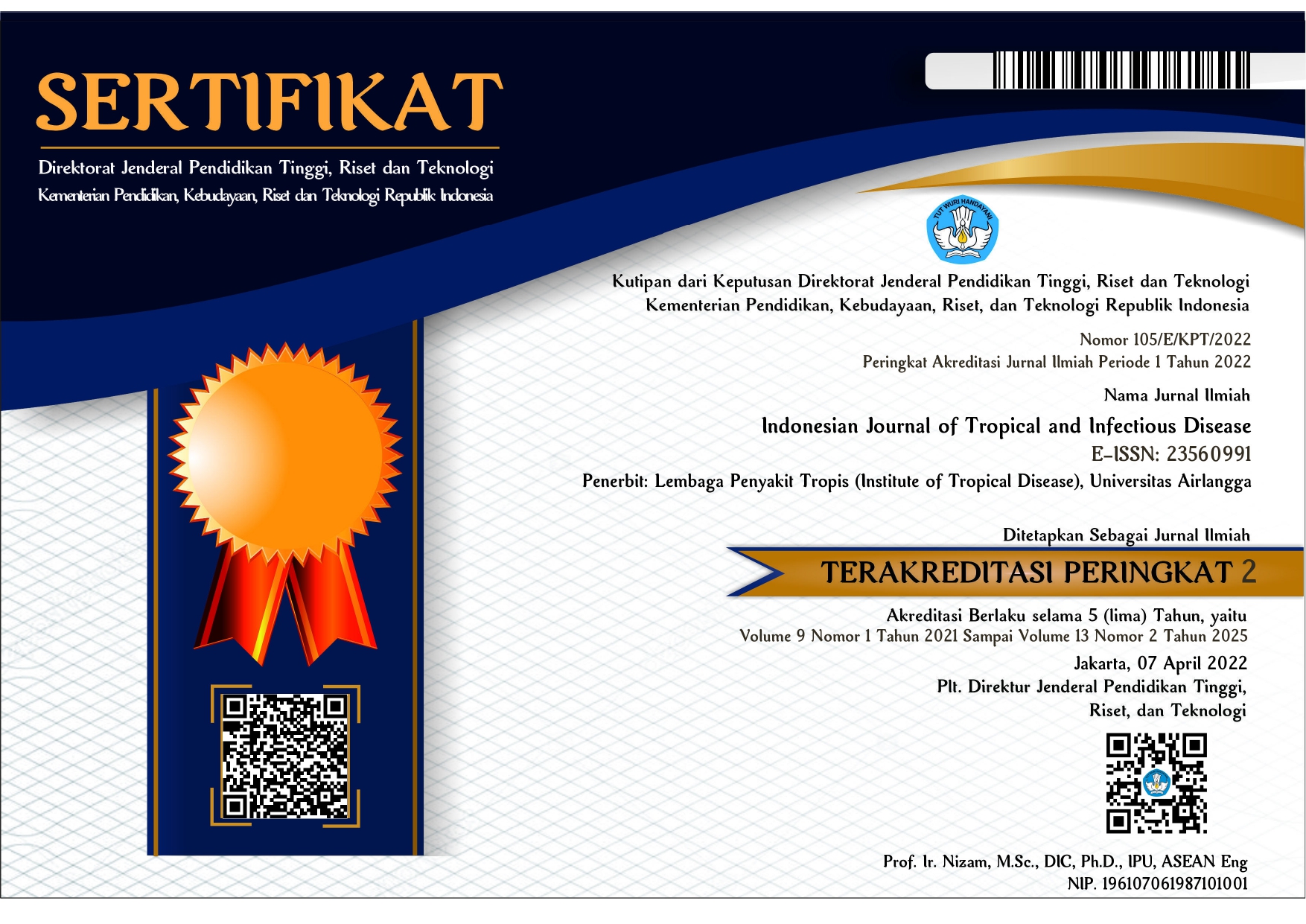RELATIONSHIP BETWEEN GROWTH RATE AND DIFFERENT TYPES OF INFECTION IN CHILDREN UNDER 5 YEARS ON WEST PAPUA
Downloads
Keusch GT. The history of nutrition: malnutrition, infection and immunity. The Journal of nutrition. 2003 Jan 1;133(1):336S-40S.
Schaible UE, Stefan HE. Malnutrition and infection: complex mechanisms and global impacts. PLoS medicine. 2007 May 1;4(5):e115.
Dewey KG, Mayers DR. Early child growth: how do nutrition and infection interact?. Maternal & child nutrition. 2011 Oct 1;7(s3):129-42.
BPPK Kemenkes RI. Riskesdas 2010 dalam angka dan buku. 2010
Black RE, Cousens S, Johnson HL, Lawn JE, Rudan I, Bassani DG, Jha P, Campbell H, Walker CF, Cibulskis R, Eisele T. Global, regional, and national causes of child mortality in 2008: a systematic analysis. The lancet. 2010 Jun 11;375(9730):1969-87.
Lundeen EA, Behrman JR, Crookston BT, Dearden KA, Engle P, Georgiadis A, Penny ME, Stein AD. Growth faltering and recovery in children aged 1–8 years in four low-and middle-income countries: Young Lives. Public health nutrition. 2014 Sep;17(9):2131-7.
Schaible UE, Stefan HE. Malnutrition and infection: complex mechanisms and global impacts. PLoS medicine. 2007 May 1;4(5):e115.
Caulfield LE, de Onis M, Blössner M, Black RE. Undernutrition as an underlying cause of child deaths associated with diarrhea, pneumonia, malaria, and measles. The American journal of clinical nutrition. 2004 Jul 1;80(1):193-8.
Cunha AL. Relationship between acute respiratory infection and malnutrition in children under 5 years of age. Acta Paediatrica. 2000 May 1;89(5):608-9.
Caulfield LE, de Onis M, Blössner M, Black RE. Undernutrition as an underlying cause of child deaths associated with diarrhea, pneumonia, malaria, and measles. The American journal of clinical nutrition. 2004 Jul 1;80(1):193-8.
Moore SR, Lima AA, Conaway MR, Schorling JB, Soares AM, Guerrant RL. Early childhood diarrhoea and helminthiases associate with long-term linear growth faltering. International journal of epidemiology. 2001 Dec 1;30(6):1457-64.
Checkley W, Buckley G, Gilman RH, Assis AM, Guerrant RL, Morris SS, Mí¸lbak K, Valentiner-Branth P, Lanata CF, Black RE, Childhood Malnutrition and Infection Network. Multi-country analysis of the effects of diarrhoea on childhood stunting. International journal of epidemiology. 2008 Jun 20;37(4):816-30.
Checkley W, Epstein LD, Gilman RH, Cabrera L, Black RE. Effects of acute diarrhea on linear growth in Peruvian children. American Journal of Epidemiology. 2003 Jan 15;157(2):166-75.
Badan Pusat Statistik, 2005b. Pedoman Pengawas dan Pemeriksa; Survei Penduduk Antar Sensus (SUPAS) 2005. Jakarta: BPS.
World Health Organization. Physical status: The use of and interpretation of anthropometry, Report of a WHO Expert Committee.
Wierzba TF, El-Yazeed RA, Savarino SJ, Mourad AS, Rao M, Baddour M, El-Deen AN, Naficy AB, Clemens JD. The interrelationship of malnutrition and diarrhea in a periurban area outside Alexandria, Egypt. Journal of pediatric gastroenterology and nutrition. 2001 Feb 1;32(2):189-96.
Moore SR, Lima NL, Soares AM, Oriá RB, Pinkerton RC, Barrett LJ, Guerrant RL, Lima AA. Prolonged episodes of acute diarrhe reduce growth and increase risk of persistent diarrhea in children. Gastroenterology. 2010 Oct 31;139(4):1156-64.
Broor S, Pandey RM, Ghosh M, Maitreyi RS, Lodha R, Singhal T, Kabra SK. Risk factors for severe acute lower respiratory tract infection in under-five children. Indian pediatrics. 2001 Dec 1;38(12):1361-9.
Weisz A, Meuli G, Thakwalakwa C, Trehan I, Maleta K, Manary M. The duration of diarrhea and fever is associated with growth faltering in rural Malawian children aged 6-18 months. Nutrition journal. 2011 Mar 20;10(1):25.
Moffat T. Diarrhea, respiratory infections, protozoan gastrointestinal parasites, and child growth in Kathmandu, Nepal. american Journal of physical anthropology. 2003 Sep 1;122(1):85-97.
Ehrhardt S, Burchard GD, Mantel C, Cramer JP, Kaiser S, Kubo M, Otchwemah RN, Bienzle U, Mockenhaupt FP. Malaria, anemia, and malnutrition in African children”defining intervention priorities.
The Journal of infectious diseases. 2006 Jul 1;194(1):108-14.
Caulfield LE, Richard SA, Black RE. Undernutrition as an underlying cause of malaria morbidity and mortality in children less than five years old. The American journal of tropical medicine and hygiene. 2004 Aug 1;71(2_suppl):55-63.
Copyright (c) 2017 Indonesian Journal of Tropical and Infectious Disease

This work is licensed under a Creative Commons Attribution-NonCommercial-ShareAlike 4.0 International License.
The Indonesian Journal of Tropical and Infectious Disease (IJTID) is a scientific peer-reviewed journal freely available to be accessed, downloaded, and used for research. All articles published in the IJTID are licensed under the Creative Commons Attribution-NonCommercial-ShareAlike 4.0 International License, which is under the following terms:
Attribution ” You must give appropriate credit, link to the license, and indicate if changes were made. You may do so reasonably, but not in any way that suggests the licensor endorses you or your use.
NonCommercial ” You may not use the material for commercial purposes.
ShareAlike ” If you remix, transform, or build upon the material, you must distribute your contributions under the same license as the original.
No additional restrictions ” You may not apply legal terms or technological measures that legally restrict others from doing anything the license permits.























